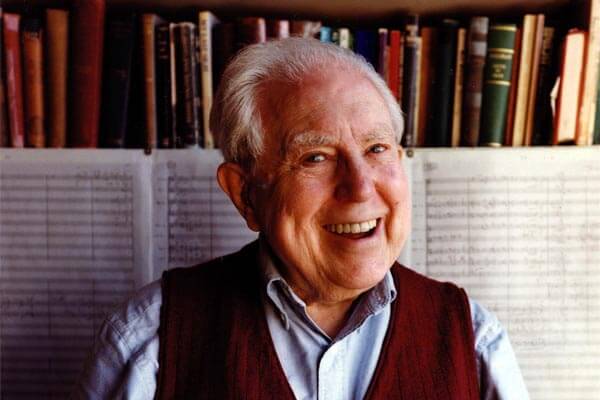 I have sometimes found performances and recordings of Elliot Carter’s music to be physically trying, requiring me to gird myself against the onslaught of hard edges, dissonance, and overwhelming complexity, leaving me to enjoy them only in very intellectual terms. But in this performance of American composers at the Wien Modern festival, Brad Lubman’s clarity of interpretation, as well as the truly astonishing acoustics of the Musikverein allowed all of the pieces on this program to reach listeners with absolute clarity, hard edges removed and full of interesting and beautiful sounds. The program was well-selected, with a coherent progression of ideas that mostly displayed the strengths of the Tonkünstler-Orchester Niederösterreich (Lower Austrian Tonkünstler Orchestra).
I have sometimes found performances and recordings of Elliot Carter’s music to be physically trying, requiring me to gird myself against the onslaught of hard edges, dissonance, and overwhelming complexity, leaving me to enjoy them only in very intellectual terms. But in this performance of American composers at the Wien Modern festival, Brad Lubman’s clarity of interpretation, as well as the truly astonishing acoustics of the Musikverein allowed all of the pieces on this program to reach listeners with absolute clarity, hard edges removed and full of interesting and beautiful sounds. The program was well-selected, with a coherent progression of ideas that mostly displayed the strengths of the Tonkünstler-Orchester Niederösterreich (Lower Austrian Tonkünstler Orchestra).

Elliott Carter – Photo by M. Heuer
The first of a three-part work, Elliot Carter’s Partita (1993) from Symphonia: sum fluxae pretium spei is deeply layered and full of trickery, written when the composer was 85 years old. Written for a very large orchestra, the piece is named “game”—the literal meaning of the Italian word. Rather than every member of the orchestra playing the same game together, however, this piece is more like a room full of children, each engaged in their own bizarre play. The tonal combinations that ensue can either sound overwhelming or fun and interesting. In this exceptional performance, Lubman conducted the orchestra through the game in his minimal, accurate style, conveying the flow and consequences of each line, pointing out how some of the performers’ games were affecting others. Watching him move the various layers throughout the orchestra helped the ear to sort out the complexity and follow Carter’s intent. Fully-focused, the orchestra played up to the challenge, with the clarinet soloist in particular doing a wonderful job of jumping easily over the snarling solo passages. This performance sounded like genuine fun, inviting the ear on little diversions to strange but somehow completely coherent musical tangents.
After this, John Cage’s Concerto for Prepared Piano and Chamber Orchestra (1950/51) served as something of a palate refresher. Emanuele Arciuli performed less as a soloist than as part of the orchestra, following the consequences of the sounds he played as they traveled across the stage. Again, the hall enhanced this performance beautifully, highlighting Cage’s experimentation with tone colors. We heard all of the details in every round combination of the clicks and clacks of prepared piano with the orchestra.
In a stroke of genius programming, Helios Choros, a ballet for orchestra (2006/7) by Augusta Read Thomas brought a welcome sense of physicality back into the evening, after the total subjugation of harmony, rhythm and melody in the first two pieces. Written to be danced to, this piece relies heavily on rhythmic elements. The orchestra played the delicate opening beautifully right up until the first brass fanfare, which announced the beginning of a driving rhythm that lasts throughout the piece. From here, the orchestra was visibly holding on, always just off the groove that Mr. Lubman was so clearly transmitting. With the cross-orchestra percussion and piano lines leading the rhythmic tearing, it was a difficult race to the finish.

Augusta Read Thomas – Photo by Jason Smith
Closing the program with Jay Schwartz’s Music for Orchestra II (2010) brought another element that had been missing in the earlier programming: the piece consists of one musical idea, developed slowly and thoroughly without diversions, quite the opposite of Partita. The idea that was developed began so quietly as to be almost inaudible, as a constantly ascending tone sliding up in the violas. It built slowly and consistently, eventually inverting as a sigh that traveled through the orchestra and grew. This piece again capitalized on the orchestra’s strength in building and sustaining complex tone colors hitting a climax with gorgeous levels of sound, and allowing the brass section to shine. The piece was big and uncomplicated, a very appropriate finish.
This concert was a rare opportunity to hear these pieces performed with great clarity. The evening was recorded, and I’m looking forward to hearing Carter’s Partita again, to find out if the focus I felt in the performance is replicated in the recording.
—
Caitlin Smith is a Canadian composer, currently based in Vienna. Follow her on Twitter: @tinyalligator.





















